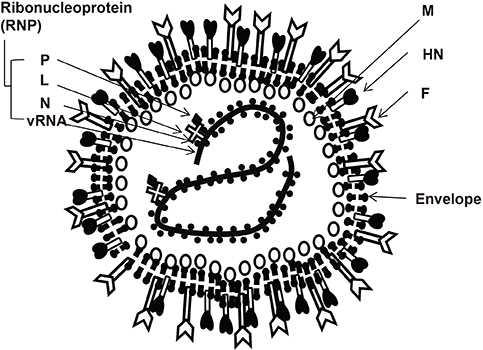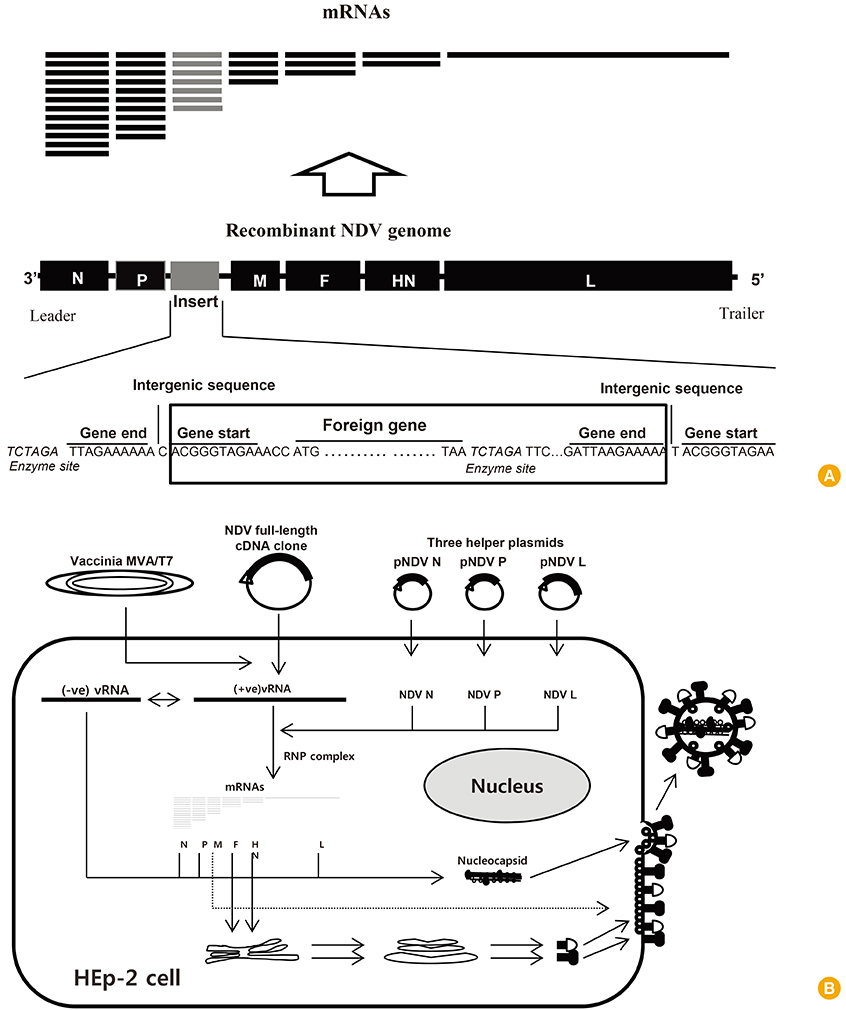Clin Exp Vaccine Res.
2017 Jul;6(2):72-82. 10.7774/cevr.2017.6.2.72.
Newcastle disease virus vectored vaccines as bivalent or antigen delivery vaccines
- Affiliations
-
- 1OIE Reference Laboratory for Newcastle Disease, Avian Disease Research Division, Animal and Plant Quarantine Agency, Gimcheon, Korea. kchoi0608@korea.kr
- KMID: 2391567
- DOI: http://doi.org/10.7774/cevr.2017.6.2.72
Abstract
- Recent advances in reverse genetics techniques make it possible to manipulate the genome of RNA viruses such as Newcastle disease virus (NDV). Several NDV vaccine strains have been used as vaccine vectors in poultry, mammals, and humans to express antigens of different pathogens. The safety, immunogenicity, and protective efficacy of these NDV-vectored vaccines have been evaluated in pre-clinical and clinical studies. The vaccines are safe in mammals, humans, and poultry. Bivalent NDV-vectored vaccines against pathogens of economic importance to the poultry industry have been developed. These bivalent vaccines confer solid protective immunity against NDV and other foreign antigens. In most cases, NDV-vectored vaccines induce strong local and systemic immune responses against the target foreign antigen. This review summarizes the development of NDV-vectored vaccines and their potential use as a base for designing other effective vaccines for veterinary and human use.
MeSH Terms
Figure
Reference
-
1. Yokoyama N, Maeda K, Mikami T. Recombinant viral vector vaccines for the veterinary use. J Vet Med Sci. 1997; 59:311–322.
Article2. Stobart CC, Moore ML. RNA virus reverse genetics and vaccine design. Viruses. 2014; 6:2531–2550.
Article3. Duan Z, Xu H, Ji X, Zhao J. Recombinant Newcastle disease virus-vectored vaccines against human and animal infectious diseases. Future Microbiol. 2015; 10:1307–1323.
Article4. Hines NL, Miller CL. Avian paramyxovirus serotype-1: a review of disease distribution, clinical symptoms, and laboratory diagnostics. Vet Med Int. 2012; 2012:708216.
Article5. Dortmans JC, Peeters BP, Koch G. Newcastle disease virus outbreaks: vaccine mismatch or inadequate application? Vet Microbiol. 2012; 160:17–22.
Article6. Tayeb S, Zakay-Rones Z, Panet A. Therapeutic potential of oncolytic Newcastle disease virus: a critical review. Oncolytic Virother. 2015; 4:49–62.7. Miller PJ, Decanini EL, Afonso CL. Newcastle disease: evolution of genotypes and the related diagnostic challenges. Infect Genet Evol. 2010; 10:26–35.
Article8. Kim SH, Samal SK. Newcastle disease virus as a vaccine vector for development of human and veterinary vaccines. Viruses. 2016; 8:E183.
Article9. Ganar K, Das M, Sinha S, Kumar S. Newcastle disease virus: current status and our understanding. Virus Res. 2014; 184:71–81.
Article10. Peeters BP, Gruijthuijsen YK, de Leeuw OS, Gielkens AL. Genome replication of Newcastle disease virus: involvement of the rule-of-six. Arch Virol. 2000; 145:1829–1845.
Article11. Park MS, Garcia-Sastre A, Cros JF, Basler CF, Palese P. Newcastle disease virus V protein is a determinant of host range restriction. J Virol. 2003; 77:9522–9532.
Article12. Huang Z, Elankumaran S, Panda A, Samal SK. Recombinant Newcastle disease virus as a vaccine vector. Poult Sci. 2003; 82:899–906.
Article13. Peeters BP, de Leeuw OS, Koch G, Gielkens AL. Rescue of Newcastle disease virus from cloned cDNA: evidence that cleavability of the fusion protein is a major determinant for virulence. J Virol. 1999; 73:5001–5009.
Article14. Romer-Oberdorfer A, Mundt E, Mebatsion T, Buchholz UJ, Mettenleiter TC. Generation of recombinant lentogenic Newcastle disease virus from cDNA. J Gen Virol. 1999; 80(Pt 11):2987–2995.
Article15. Huang Z, Krishnamurthy S, Panda A, Samal SK. High-level expression of a foreign gene from the most 3'-proximal locus of a recombinant Newcastle disease virus. J Gen Virol. 2001; 82(Pt 7):1729–1736.
Article16. Carnero E, Li W, Borderia AV, Moltedo B, Moran T, Garcia-Sastre A. Optimization of human immunodeficiency virus Gag expression by Newcastle disease virus vectors for the induction of potent immune responses. J Virol. 2009; 83:584–597.
Article17. Zhao W, Zhang Z, Zsak L, Yu Q. P and M gene junction is the optimal insertion site in Newcastle disease virus vaccine vector for foreign gene expression. J Gen Virol. 2015; 96(Pt 1):40–45.
Article18. Samal SK. Newcastle disease and related avian paramyxoviruses. In : Samal SK, editor. The biology of paramyxoviruses. Norfolk: Caister Academic Press;2011. p. 69–114.19. Khattar SK, Collins PL, Samal SK. Immunization of cattle with recombinant Newcastle disease virus expressing bovine herpesvirus-1 (BHV-1) glycoprotein D induces mucosal and serum antibody responses and provides partial protection against BHV-1. Vaccine. 2010; 28:3159–3170.
Article20. Zhang M, Ge J, Wen Z, et al. Characterization of a recombinant Newcastle disease virus expressing the glycoprotein of bovine ephemeral fever virus. Arch Virol. 2017; 162:359–367.
Article21. Kortekaas J, Dekker A, de Boer SM, et al. Intramuscular inoculation of calves with an experimental Newcastle disease virus-based vector vaccine elicits neutralizing antibodies against Rift Valley fever virus. Vaccine. 2010; 28:2271–2276.
Article22. Zhang M, Ge J, Li X, et al. Protective efficacy of a recombinant Newcastle disease virus expressing glycoprotein of vesicular stomatitis virus in mice. Virol J. 2016; 13:31.
Article23. Ge J, Wang X, Tian M, et al. Recombinant Newcastle disease viral vector expressing hemagglutinin or fusion of canine distemper virus is safe and immunogenic in minks. Vaccine. 2015; 33:2457–2462.
Article24. Ge J, Wang X, Tao L, et al. Newcastle disease virus-vectored rabies vaccine is safe, highly immunogenic, and provides long-lasting protection in dogs and cats. J Virol. 2011; 85:8241–8252.
Article25. Kong D, Wen Z, Su H, et al. Newcastle disease virus-vectored Nipah encephalitis vaccines induce B and T cell responses in mice and long-lasting neutralizing antibodies in pigs. Virology. 2012; 432:327–335.
Article26. Wang J, Yang J, Ge J, et al. Newcastle disease virus-vectored West Nile fever vaccine is immunogenic in mammals and poultry. Virol J. 2016; 13:109.
Article27. Samy AM, Peterson AT, Hall M. Phylogeography of Rift Valley fever virus in Africa and the Arabian peninsula. PLoS Negl Trop Dis. 2017; 11:e0005226.
Article28. Botros B, Omar A, Elian K, et al. Adverse response of non-indigenous cattle of European breeds to live attenuated Smithburn Rift Valley fever vaccine. J Med Virol. 2006; 78:787–791.
Article29. Kamal SA. Pathological studies on postvaccinal reactions of Rift Valley fever in goats. Virol J. 2009; 6:94.
Article30. Dietzschold B, Schnell M, Koprowski H. Pathogenesis of rabies. Curr Top Microbiol Immunol. 2005; 292:45–56.
Article31. World Health Organization. WHO expert consultation on rabies. First report. WHO Technical Report Series 931. Geneva: World Health Organization;2005.32. Carnero E, Li W, Borderia AV, Moltedo B, Moran T, García-Sastre A. Optimization of human immunodeficiency virus Gag expression by Newcastle disease virus vectors for the induction of potent immune responses. J Virol. 2009; 83:584–597.
Article33. Khattar SK, Samal S, Devico AL, Collins PL, Samal SK. Newcastle disease virus expressing human immunodeficiency virus type 1 envelope glycoprotein induces strong mucosal and serum antibody responses in Guinea pigs. J Virol. 2011; 85:10529–10541.
Article34. Khattar SK, Manoharan V, Bhattarai B, LaBranche CC, Montefiori DC, Samal SK. Mucosal immunization with Newcastle disease virus vector coexpressing HIV-1 Env and Gag proteins elicits potent serum, mucosal, and cellular immune responses that protect against vaccinia virus Env and Gag challenges. MBio. 2015; 6:e01005.
Article35. Nakaya T, Cros J, Park MS, et al. Recombinant Newcastle disease virus as a vaccine vector. J Virol. 2001; 75:11868–11873.
Article36. DiNapoli JM, Yang L, Suguitan A Jr, et al. Immunization of primates with a Newcastle disease virus-vectored vaccine via the respiratory tract induces a high titer of serum neutralizing antibodies against highly pathogenic avian influenza virus. J Virol. 2007; 81:11560–11568.
Article37. DiNapoli JM, Kotelkin A, Yang L, et al. Newcastle disease virus, a host range-restricted virus, as a vaccine vector for intranasal immunization against emerging pathogens. Proc Natl Acad Sci U S A. 2007; 104:9788–9793.
Article38. DiNapoli JM, Yang L, Samal SK, Murphy BR, Collins PL, Bukreyev A. Respiratory tract immunization of non-human primates with a Newcastle disease virus-vectored vaccine candidate against Ebola virus elicits a neutralizing antibody response. Vaccine. 2010; 29:17–25.
Article39. Kim SH, Chen S, Jiang X, Green KY, Samal SK. Newcastle disease virus vector producing human norovirus-like particles induces serum, cellular, and mucosal immune responses in mice. J Virol. 2014; 88:9718–9727.
Article40. Martinez-Sobrido L, Gitiban N, Fernandez-Sesma A, et al. Protection against respiratory syncytial virus by a recombinant Newcastle disease virus vector. J Virol. 2006; 80:1130–1139.
Article41. Bukreyev A, Huang Z, Yang L, et al. Recombinant newcastle disease virus expressing a foreign viral antigen is attenuated and highly immunogenic in primates. J Virol. 2005; 79:13275–13284.
Article42. Swayne DE, Spackman E, Pantin-Jackwood M. Success factors for avian influenza vaccine use in poultry and potential impact at the wild bird-agricultural interface. Ecohealth. 2014; 11:94–108.
Article43. Peyre M, Fusheng G, Desvaux S, Roger F. Avian influenza vaccines: a practical review in relation to their application in the field with a focus on the Asian experience. Epidemiol Infect. 2009; 137:1–21.
Article44. Chen H. H5N1 avian influenza vaccination in China. In : OIE Regional Workshop on Enhancing Influenza A Viruses National Surveillance; 2014 Aug 26-28; Tokyo, Japan.45. Ge J, Deng G, Wen Z, et al. Newcastle disease virus-based live attenuated vaccine completely protects chickens and mice from lethal challenge of homologous and heterologous H5N1 avian influenza viruses. J Virol. 2007; 81:150–158.
Article46. Park MS, Steel J, Garcia-Sastre A, Swayne D, Palese P. Engineered viral vaccine constructs with dual specificity: avian influenza and Newcastle disease. Proc Natl Acad Sci U S A. 2006; 103:8203–8208.
Article47. Chen HY, Shang YH, Yao HX, et al. Immune responses of chickens inoculated with a recombinant fowlpox vaccine coexpressing HA of H9N2 avain influenza virus and chicken IL-18. Antiviral Res. 2011; 91:50–56.
Article48. Li C, Bu Z, Chen H. Avian influenza vaccines against H5N1 ‘bird flu’. Trends Biotechnol. 2014; 32:147–156.
Article49. Suarez DL, Pantin-Jackwood MJ. Recombinant viral-vectored vaccines for the control of avian influenza in poultry. Vet Microbiol. 2016; 11. 24. [Epub]. DOI: 10.1016/j.vetmic.2016.11.025.
Article50. Nayak B, Rout SN, Kumar S, et al. Immunization of chickens with Newcastle disease virus expressing H5 hemagglutinin protects against highly pathogenic H5N1 avian influenza viruses. PLoS One. 2009; 4:e6509.
Article51. Steglich C, Grund C, Ramp K, et al. Chimeric newcastle disease virus protects chickens against avian influenza in the presence of maternally derived NDV immunity. PLoS One. 2013; 8:e72530.
Article52. Huang Z, Elankumaran S, Yunus AS, Samal SK. A recombinant Newcastle disease virus (NDV) expressing VP2 protein of infectious bursal disease virus (IBDV) protects against NDV and IBDV. J Virol. 2004; 78:10054–10063.
Article53. Toro H, Zhao W, Breedlove C, Zhang Z, Yu Q, Van Santen V. Infectious bronchitis virus S2 expressed from recombinant virus confers broad protection against challenge. Avian Dis. 2014; 58:83–89.
Article54. Kanabagatte Basavarajappa M, Kumar S, Khattar SK, Gebreluul GT, Paldurai A, Samal SK. A recombinant Newcastle disease virus (NDV) expressing infectious laryngotracheitis virus (ILTV) surface glycoprotein D protects against highly virulent ILTV and NDV challenges in chickens. Vaccine. 2014; 32:3555–3563.
Article55. Zhao W, Spatz S, Zhang Z, et al. Newcastle disease virus (NDV) recombinants expressing infectious laryngotracheitis virus (ILTV) glycoproteins gB and gD protect chickens against ILTV and NDV challenges. J Virol. 2014; 88:8397–8406.
Article56. Kim SH, Paldurai A, Samal SK. A novel chimeric Newcastle disease virus vectored vaccine against highly pathogenic avian influenza virus. Virology. 2017; 503:31–36.
Article57. Hu H, Roth JP, Estevez CN, Zsak L, Liu B, Yu Q. Generation and evaluation of a recombinant Newcastle disease virus expressing the glycoprotein (G) of avian metapneumovirus subgroup C as a bivalent vaccine in turkeys. Vaccine. 2011; 29:8624–8633.
Article58. Guy JS, Barnes HJ, Smith L. Increased virulence of modified-live infectious laryngotracheitis vaccine virus following bird-to-bird passage. Avian Dis. 1991; 35:348–355.
Article59. Hughes CS, Williams RA, Gaskell RM, et al. Latency and reactivation of infectious laryngotracheitis vaccine virus. Arch Virol. 1991; 121:213–218.
Article
- Full Text Links
- Actions
-
Cited
- CITED
-
- Close
- Share
- Similar articles
-
- The present and future of rabies vaccine in animals
- Microneedle patches for vaccine delivery
- Current status of human papillomavirus vaccines
- Construction of Recombinant DNA with F and HN Genes of Newcastle Disease Virus and Its Immunogenicity
- Improved immunogenicity of Newcastle disease virus inactivated vaccine following DNA vaccination using Newcastle disease virus hemagglutinin-neuraminidase and fusion protein genes



